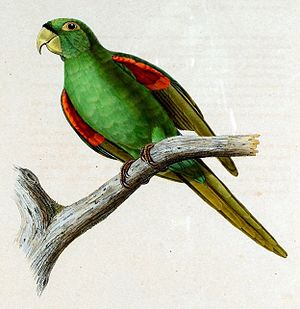Puerto Rican Parakeet
| Puerto Rican Parakeet | ||||||||||
|---|---|---|---|---|---|---|---|---|---|---|

Puerto Rican Parakeet ( Psittacara maugei ) |
||||||||||
| Systematics | ||||||||||
|
||||||||||
| Scientific name | ||||||||||
| Psittacara maugei | ||||||||||
| Souancé , 1856 |
The Puerto Rican Parakeet ( Psittacara maugei ) is an extinct species of parrot that was native to Mona Island and believed to be native to Puerto Rico . It was closely related to the Haiti parakeet ( Psittacara chloropterus ) and was at times considered its subspecies. Based on a 2015 morphological study by Storrs Lovejoy Olson , it was granted species status in 2016 by the American Ornithologists' Union and the International Ornithological Congress. This parakeet is named after the French zoologist René Maugé .
features
The Puerto Rican parakeet looked very similar to the Haiti parakeet. It reached a length of 32 cm. The plumage was mostly green. The bend of the wing and under wing-coverts were red and the forehead sometimes had red feathers. Individual red feathers often shimmered through the green plumage. The beak was pinkish-yellow. There was bald gray-white skin around the eyes. The iris was yellowish-orange. The legs and feet were gray. Compared to the Haiti parakeet, the Puerto Rico parakeet was slightly smaller, the beak darker, the red color under the hand covers lighter. The little hand covers were completely green with no reddish feathers.
die out
The last specimen of the Puerto Rican parakeet was shot in 1892 by a bird collector named Wilmot W. Brown. In Puerto Rico, where the Puerto Rican parakeet is only known through stories, it probably died out around 1860. In 1883 the Puerto Rican explorer Agustín Stahl noted in the article Contributions to the Bird Fauna of Portorico :
"Dr. J. Gundlach, a German zoologist who worked in Cuba for forty-five years, has earned credit for his tireless work, especially through his research into our animal kingdom. His in the journals f. Ornithology, year 1878, p. 157 u. ff., published list and brief reports about our birds raises the number only in 153 species, one of which, Conurus euops, has long been extinct. Old people of today remember having heard from their parents that this little parrot existed in those ancient times and that there were even flocks causing damage in the plantations, but that it was soon completely exterminated by tireless persecution. "
In 1874, Juan Gundlach suspected that the Puerto Rican parakeet must still exist in the eastern forests of Puerto Rico. While James Lee Peters classified the Puerto Rican parakeet as still existing on Mona in 1937, it was finally declared extinct by James Bond in 1956 . The cause of extinction is the destruction of the forests and overhunting as a supposed pest. Today there are three museum specimens in the Field Museum of Natural History in Chicago , in the Museum Naturalis in Leiden and in the Muséum national d'histoire naturelle in Paris .
Systematics
The Puerto Rican parakeet was described by Charles de Souancé as Psittacara maugei in 1856 . In 1916 it was classified as a subspecies by Robert Ridgway . Even if this taxon is widely recognized today, the American ornithologist James Cowan Greenway expressed doubts about its validity in 1967. He stated that only one of the three existing bellows was compared with the nominate form and was of the opinion that it was almost indistinguishable from the Haiti parakeet. In 2015, Storrs Olson suggested restoring the species status because there are morphological differences in plumage and beak that would justify separating the two taxa. Furthermore, finds of subfossil bone material on Puerto Rico could also be an indication of an independent species.
Individual evidence
- ↑ a b Olson, SL (2015). History, morphology, and fossil record of the extinct Puerto Rican Parakeet Psittacara maugei Souancé. Wilson J Ornithol 127 (1): 1-12.
- ↑ 2016 AOU Supplement is Out!
- ^ IOC World Bird List
- ↑ Stahl, Agustin: Contributions to the bird fauna of Portorico In: Ornis No. 3, 1883, p. 448 ( online version )
- ^ Gundlach, Juan: Contributions to the ornithology of the island of Portorico In: Journal for ornithology 22 (127), 1874, pp. 304-315
- ↑ Peters, James Lee: Check-list of the Birds of the World, Vol. 3 , Harvard University Press, Cambridge, 1937, p. 188
- ↑ Bond, James: Check-list of the Birds of the West Indies , 4th Edition, Philadelphia: Academy of Natural Sciences of Philadelphia, 1956
- ^ Greenway, 1967, p. 321
literature
- Dieter Luther: The extinct birds of the world . 4th edition (Die neue Brehm-Bücherei 424). Westarp Sciences, Magdeburg; Spektrum, Heidelberg 1996. ISBN 3-89432-213-6 , p. 112
- David Day: The Doomsday Book of Animals. Ebury Press, London 1981. ISBN 0-670-27987-0 , p. 76
- James Greenway: Extinct and Vanishing Birds of the World. Dover Publications Inc. New York 1967. ISBN 0-486-21869-4 , p. 321
- Michael Walters & Julian Pender Hume: Extinct Birds . Poiser Monographes (A & C Black), 2012. ISBN 978-1-4081-5725-1 , p. 185.
- James Bond (May 15, 1946). The birds of Mona Island . Notulae Naturae (Philadelphia Academy of Sciences) (176). ISBN 1-60483-176-6 . Online version
